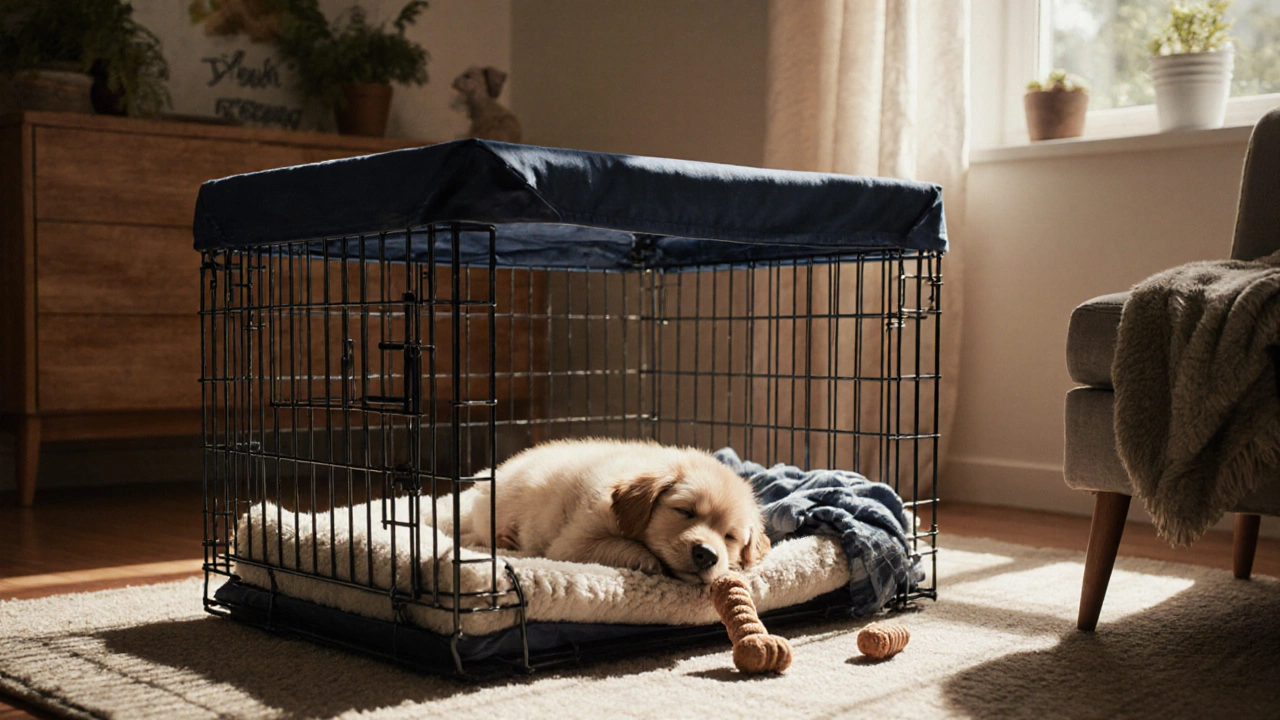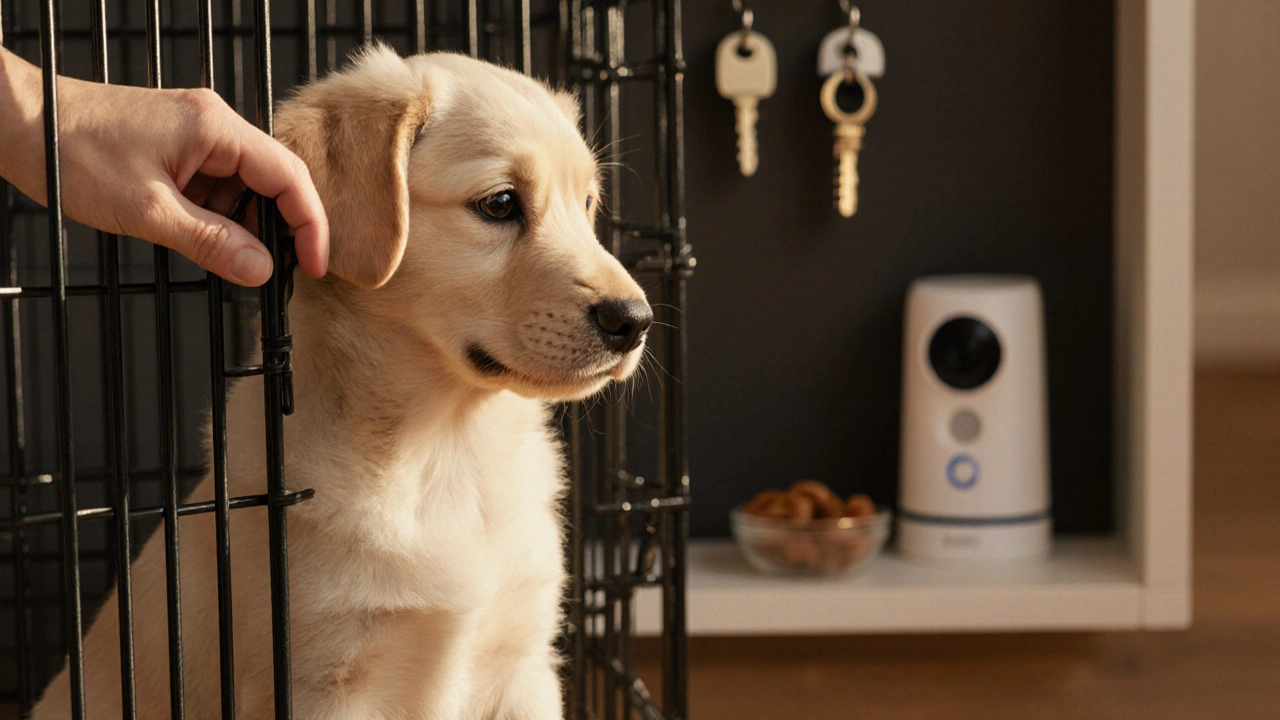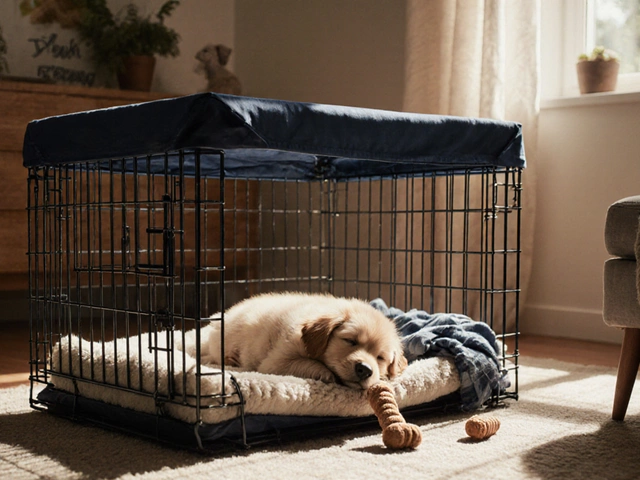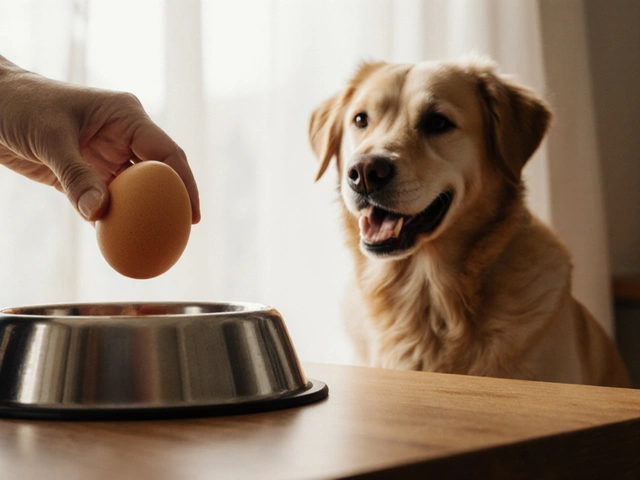
You’ve got a new puppy. Cute, energetic, and full of curiosity. But now you’re staring at the crate wondering: should I lock my puppy in his crate during the day? It’s a common worry-and a lot of advice out there is conflicting. Some say crating is cruel. Others say it’s the only way to keep your pup safe and sane. The truth? It’s not about locking your puppy away. It’s about using the crate right.
Why Crates Work for Puppies
Puppies are den animals. In the wild, they’d sleep in a snug, dark space with their littermates. A crate mimics that. When used properly, it becomes a safe haven, not a prison. A well-trained puppy will choose to go into their crate when they’re tired. They don’t see it as punishment-they see it as their spot.But here’s the catch: crating only works if it’s introduced slowly and never used as a dumping ground. If you shove your puppy in for eight hours straight because you’re busy, you’re setting them up for stress, accidents, or even destructive behavior. That’s not training. That’s neglect.
How Long Is Too Long?
There’s a simple rule: your puppy can hold it for about one hour per month of age, plus one. So a 3-month-old puppy? About 4 hours max. A 5-month-old? Around 6 hours. That’s not a target-it’s the ceiling. Pushing beyond that leads to bladder issues, anxiety, and learned helplessness.Real talk: if you’re at work for 8 hours, you shouldn’t leave your puppy crated the whole time. Not even once. You need a plan. That could mean:
- Coming home at lunch to let them out
- Hiring a dog walker for a midday break
- Setting up a puppy-proofed room with a pee pad and toys
- Asking a neighbor or friend to check in
Some people think, “But my dog sleeps all day anyway!” That’s not true. Puppies sleep in bursts-20 minutes here, 40 minutes there. They wake up hungry, bored, or needing to go out. Leaving them crated for hours means they’ll either hold it until they can’t… or they’ll pee in their crate. And once that happens, they’ll start associating their safe space with mess and shame.
The Right Way to Use a Crate
A crate isn’t a timeout chair. It’s a tool. And like any tool, it needs to be used with intention.Start with short sessions. Feed meals inside. Give chew toys only in the crate. Make it a happy place. Don’t close the door and walk away. Let your puppy go in and out freely at first. Then, when they’re calm, close the door for 5 minutes. Gradually build up. By the time they’re 6 months old, they should happily nap in there while you’re cooking dinner or watching TV.
Here’s what works in real life:
- Place the crate in a busy part of the house-like the living room. Puppies don’t like being isolated.
- Use a soft bed, a favorite toy, and maybe a piece of your clothing for scent.
- Never use the crate for punishment. Ever.
- Open the door as soon as they’re quiet. If they whine, wait until they stop. Reward silence, not crying.
- At night, keep the crate near your bed. Puppies need reassurance.

What Happens If You Overdo It?
I’ve seen it too many times. A puppy gets crated for 7 hours a day, 5 days a week, from 8 weeks to 6 months. Then, when they’re finally free, they:- Chew the couch
- Pee on the rug
- Whine nonstop when left alone
- Act terrified of the crate
That’s not a well-behaved dog. That’s a traumatized one. Crate overuse leads to separation anxiety. It teaches your puppy that being alone = bad. And that’s hard to undo.
One owner in Auckland told me her 4-month-old pup, Luna, started shaking every time she picked up her keys. Turns out, the crate had become a place of abandonment. She spent 3 months retraining Luna with positive associations. Took patience. Took time. But it worked.
Alternatives to All-Day Crating
You don’t have to choose between crating and chaos. There are middle grounds.**Puppy-proofed room:** Block off a small room with a baby gate. Put down a pee pad, water, toys, and a bed. Make sure there are no chewable cords or toxic plants. This gives your puppy space to move, explore, and rest without being locked in.
**Doggy daycare:** A few hours a week at a reputable facility gives your pup socialization, exercise, and mental stimulation. Many places in Auckland offer drop-in services for under $30 a day.
**Pet cameras with treat dispensers:** If you’re worried about your puppy being alone, get a camera with two-way audio and a treat dispenser. You can talk to them, reward calm behavior, and even toss a treat to distract them if they start barking.

When Crating Is a Red Flag
There are times when crating isn’t just unhelpful-it’s dangerous.- If your puppy is under 8 weeks old: Their bladder control is still developing. Crating too long can cause urinary tract infections.
- If your puppy has a medical condition: Diabetes, kidney issues, or neurological problems mean they can’t hold it.
- If your puppy is showing signs of stress: Panting, drooling, trembling, or refusing to eat in the crate? Stop. Talk to a vet or behaviorist.
- If you’re using the crate because you’re too busy to train: That’s not a solution. It’s a shortcut that costs your puppy their trust.
What Experts Say
The New Zealand Companion Animal Council recommends that puppies under 6 months should not be left alone for more than 4 hours without a break. The American Veterinary Society of Animal Behavior agrees: crating should never be used as a long-term solution for unsupervised time.And here’s something most people don’t realize: crating isn’t the goal. House training and independence are. A well-trained puppy doesn’t need to be locked up. They learn to wait, to relax, to be calm-even when you’re not home.
Think of the crate like a car seat. You use it when you’re moving. You don’t strap them in and leave them there all day.
Final Answer: Should You Lock Your Puppy in His Crate During the Day?
Yes-but only for short, controlled periods. No more than 4 hours for a 4-month-old. Always give them a break. Always make it positive. Always pair it with play, training, and human interaction.If you’re gone for longer, use a puppy-proofed room or hire help. Your puppy isn’t a pet you store. They’re a living, feeling being who needs connection, movement, and safety. The crate is a tool to help them learn. Not a cage to hide them away.
Train with patience. Be consistent. Reward calm. And remember: the goal isn’t to keep your puppy quiet. It’s to raise a confident, well-adjusted dog who feels safe-even when you’re not there.
Can I leave my puppy in the crate all day while I work?
No. Puppies under 6 months old can’t hold their bladder for more than 4-6 hours. Leaving them crated all day leads to accidents, anxiety, and trust issues. Use a puppy-proofed room, dog walker, or daycare instead.
Is crating a puppy cruel?
Not if done right. A crate is a safe den when introduced positively. But if used as punishment, for too long, or without breaks, it becomes cruel. The difference is intention and timing.
How do I get my puppy to like their crate?
Feed meals inside, give treats and chew toys only in the crate, and never force them in. Let them explore it on their own. Make it cozy with a blanket and your scent. Over time, they’ll choose to go in.
Should I cover my puppy’s crate at night?
A light blanket over the top can help create a den-like feel, especially for anxious puppies. But don’t fully enclose it-keep airflow open. Never use it to silence whining. That’s not comfort-it’s suppression.
My puppy cries in the crate. Should I let them out?
Wait until they stop crying. If you let them out while they’re whining, you’re teaching them that crying gets results. Wait for silence, then reward it with calm praise. If they cry for more than 15-20 minutes, check if they need to go out or are in distress.








Write a comment